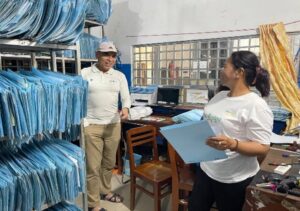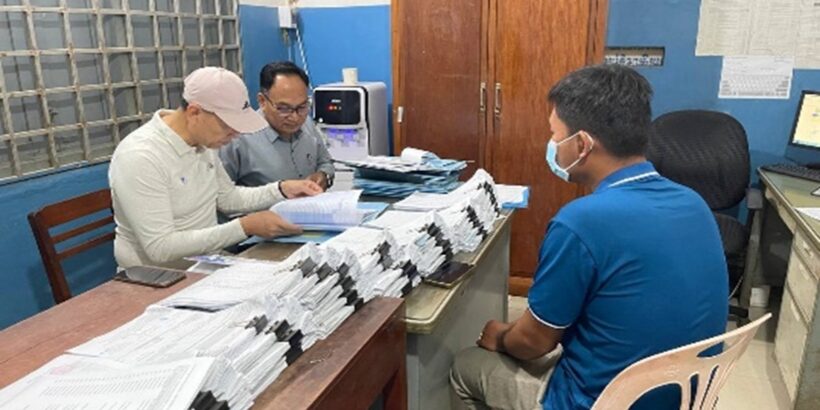This blog is part of a series on data collection, highlighting how local data are identified and used by countries to understand typhoid burden and aid in decision-making for TCV introduction. Click here to read about typhoid data collection efforts in Burkina Faso.
Up-to-date, accurate data on typhoid burden is critical for countries as they consider their typhoid prevention and control strategies, including the decision to introduce typhoid conjugate vaccines (TCVs). However, collecting local data is often a complicated process.
We spoke to Dr. Soy Ty Kheang, a data consultant based in Phnom Penh, Cambodia, about his work gathering local data on typhoid burden in the country.
Can you tell us about your experience with typhoid and typhoid conjugate vaccines? How did you come to work in this area?
I have worked in public health for over twenty years, with a focus on disease prevention through behavior change and vaccination programs. My work has included developing vaccination strategies and community-based prevention programs for malaria, tuberculosis (TB), HIV, and other communicable diseases across Cambodia and Southeast Asia, as well as leading disease surveillance efforts for malaria and TB through multiple national malaria indicator surveys and the Cambodian National TB Prevalence survey.
I have always been a strong advocate for vaccination as a critical tool to prevent disease, and my current work includes promoting vaccination uptake in vulnerable populations and contributing to policy discussions on the introduction of new vaccines, including TCVs, in Cambodia.
Why is it important to understand typhoid disease burden?
Typhoid is challenging and costly to diagnose, which often leads to significant underestimation of its true burden. Reliable data on typhoid incidence is essential for guiding policymakers in making evidence-based decisions on the introduction of effective prevention measures, such as TCVs.
In Cambodia, for instance, urban and coastal regions—particularly Phnom Penh and Sihanoukville—report the highest rates of typhoid morbidity, especially during the rainy season. Understanding these geographic and seasonal risk factors enables the development of targeted prevention strategies and allows for more efficient allocation of resources to protect vulnerable populations.
How did you identify optimal locations to collect typhoid samples and data?
Our objective was to gather comprehensive data that accurately reflect the full burden of typhoid in Cambodia. To achieve this, we selected four study sites representing diverse regions across the country, including national, provincial, and district-level hospitals. These included the Angkor Hospital for Children in Siem Reap town and the National Pediatric Hospital in Phnom Penh, as well as Sotnikum District Referral Hospital and Pouk District Referral Hospital in Siem Reap province.
While no dataset is ever perfect, surveying facilities across varying contexts allows for a more representative understanding of the national typhoid landscape.
What challenges did you encounter with local data collection, and how did you overcome them?
Getting the full picture of typhoid burden is often challenging, as typhoid’s symptoms are similar to those of many other diseases. Many diagnoses are based on clinical symptoms rather than the blood culture method, which leads to frequent misdiagnosis. Even when blood cultures are done, only about half of typhoid cases are correctly identified, potentially underestimating burden.
Hospital records themselves don’t always provide complete data. Registries and clinic logbooks can become damaged or illegible, and sometimes records are incomplete. Searching through hospital records is a labor-intensive process that takes time and perseverance.

A major challenge in data collection at the district and facility levels was missing or incomplete data in patient files. Many records, which are still paper based, lack essential information, and in some cases entire patient files were unavailable. To address these gaps, the HSD team—made up of national and local staff working to collect data, implement programmatic interventions, and engage in ongoing monitoring and improvement—collaborated with health facility staff to retrieve data from alternative sources, including patient registration logs, laboratory records, and, where feasible, direct patient interviews.
During the data collection process, what procedures are in place to ensure the data are valid and useful for typhoid conjugate vaccine decision-making?
We followed a detailed quality assurance process to ensure the data were accurate and useful. Because hospital records are imperfect, it can be difficult to track a patient through the entire process: from intake, to being diagnosed with typhoid, to potentially receiving antibiotics and any other outcomes. We followed procedures for data verification and validation, including double-entry and cross-checking data with source documents.
HSD supervisors reviewed data collected at the facility and district levels to ensure its accuracy and completeness. In addition, they played a key role in troubleshooting and coordinating with Ministry of Health staff to resolve any issues related to data access or availability.
By following these procedures, we have a high level of confidence that the data collected are accurate and representative of typhoid burden throughout Cambodia. These data are triangulated with data from peer-reviewed publications, modeled data, and data from neighboring countries. We plan to share our results with key stakeholders to help support the country’s decision-making around TCV introduction.
Cover photo: Dr. Soy Ty, Dr. Saroeun, & Mr. Bun Hul in Sotnikum District Referral Hospital checking the medical facility files.



